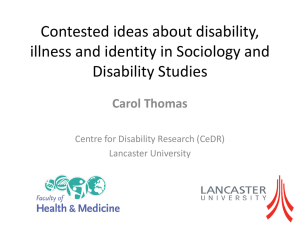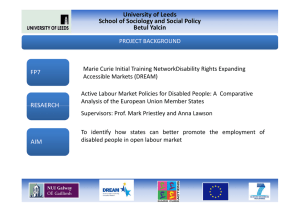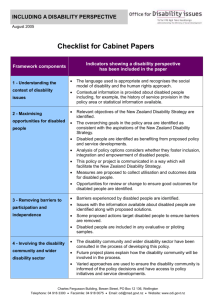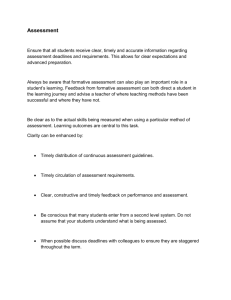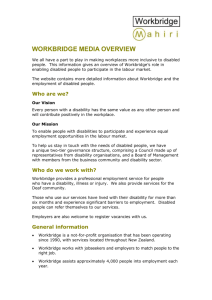A Guide for employers - Diversity and Equal Opportunity Centre
advertisement
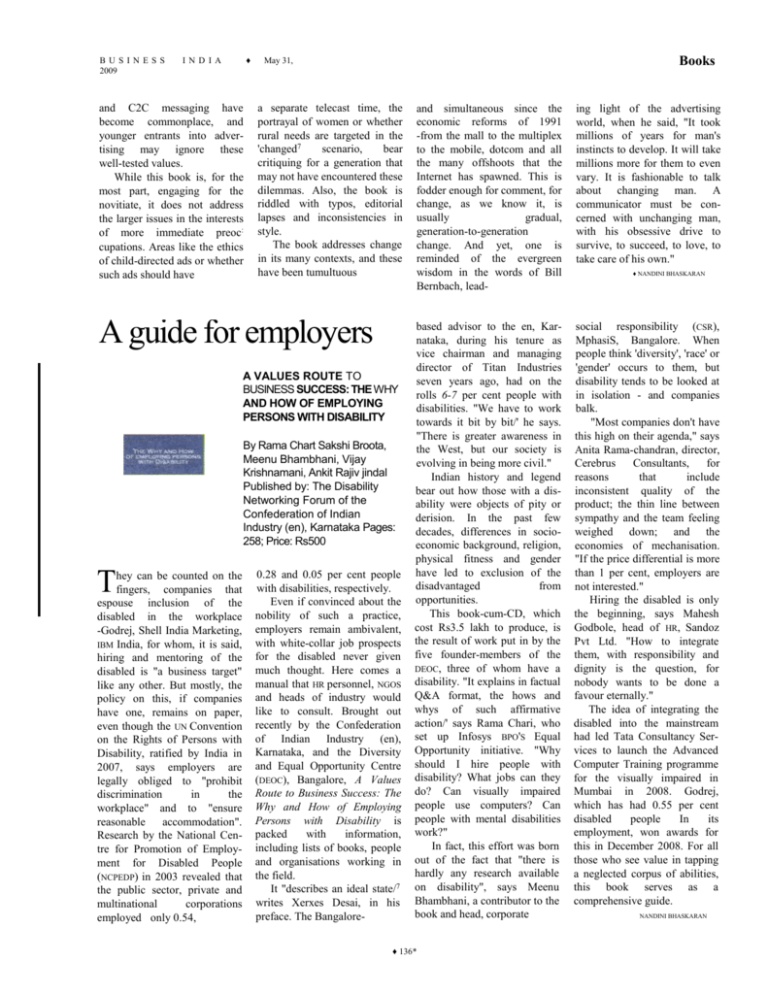
BUSINESS 2009 ♦ IND I A and C2C messaging have become commonplace, and younger entrants into advertising may ignore these well-tested values. While this book is, for the most part, engaging for the novitiate, it does not address the larger issues in the interests of more immediate preoc: cupations. Areas like the ethics of child-directed ads or whether such ads should have May 31, Books a separate telecast time, the portrayal of women or whether rural needs are targeted in the 'changed7 scenario, bear critiquing for a generation that may not have encountered these dilemmas. Also, the book is riddled with typos, editorial lapses and inconsistencies in style. The book addresses change in its many contexts, and these have been tumultuous A guide for employers A VALUES ROUTE TO BUSINESS SUCCESS: THE WHY AND HOW OF EMPLOYING PERSONS WITH DISABILITY By Rama Chart Sakshi Broota, Meenu Bhambhani, Vijay Krishnamani, Ankit Rajiv jindal Published by: The Disability Networking Forum of the Confederation of Indian Industry (en), Karnataka Pages: 258; Price: Rs500 T hey can be counted on the fingers, companies that espouse inclusion of the disabled in the workplace -Godrej, Shell India Marketing, IBM India, for whom, it is said, hiring and mentoring of the disabled is "a business target" like any other. But mostly, the policy on this, if companies have one, remains on paper, even though the UN Convention on the Rights of Persons with Disability, ratified by India in 2007, says employers are legally obliged to "prohibit discrimination in the workplace" and to "ensure reasonable accommodation". Research by the National Centre for Promotion of Employment for Disabled People (NCPEDP) in 2003 revealed that the public sector, private and multinational corporations employed only 0.54, 0.28 and 0.05 per cent people with disabilities, respectively. Even if convinced about the nobility of such a practice, employers remain ambivalent, with white-collar job prospects for the disabled never given much thought. Here comes a manual that HR personnel, NGOS and heads of industry would like to consult. Brought out recently by the Confederation of Indian Industry (en), Karnataka, and the Diversity and Equal Opportunity Centre (DEOC), Bangalore, A Values Route to Business Success: The Why and How of Employing Persons with Disability is packed with information, including lists of books, people and organisations working in the field. It "describes an ideal state/7 writes Xerxes Desai, in his preface. The Bangalore- and simultaneous since the economic reforms of 1991 -from the mall to the multiplex to the mobile, dotcom and all the many offshoots that the Internet has spawned. This is fodder enough for comment, for change, as we know it, is usually gradual, generation-to-generation change. And yet, one is reminded of the evergreen wisdom in the words of Bill Bernbach, lead- ing light of the advertising world, when he said, "It took millions of years for man's instincts to develop. It will take millions more for them to even vary. It is fashionable to talk about changing man. A communicator must be concerned with unchanging man, with his obsessive drive to survive, to succeed, to love, to take care of his own." based advisor to the en, Karnataka, during his tenure as vice chairman and managing director of Titan Industries seven years ago, had on the rolls 6-7 per cent people with disabilities. "We have to work towards it bit by bit/' he says. "There is greater awareness in the West, but our society is evolving in being more civil." Indian history and legend bear out how those with a disability were objects of pity or derision. In the past few decades, differences in socioeconomic background, religion, physical fitness and gender have led to exclusion of the disadvantaged from opportunities. This book-cum-CD, which cost Rs3.5 lakh to produce, is the result of work put in by the five founder-members of the DEOC, three of whom have a disability. "It explains in factual Q&A format, the hows and whys of such affirmative action/' says Rama Chari, who set up Infosys BPO'S Equal Opportunity initiative. "Why should I hire people with disability? What jobs can they do? Can visually impaired people use computers? Can people with mental disabilities work?" In fact, this effort was born out of the fact that "there is hardly any research available on disability", says Meenu Bhambhani, a contributor to the book and head, corporate social responsibility (CSR), MphasiS, Bangalore. When people think 'diversity', 'race' or 'gender' occurs to them, but disability tends to be looked at in isolation - and companies balk. "Most companies don't have this high on their agenda," says Anita Rama-chandran, director, Cerebrus Consultants, for reasons that include inconsistent quality of the product; the thin line between sympathy and the team feeling weighed down; and the economies of mechanisation. "If the price differential is more than 1 per cent, employers are not interested." Hiring the disabled is only the beginning, says Mahesh Godbole, head of HR, Sandoz Pvt Ltd. "How to integrate them, with responsibility and dignity is the question, for nobody wants to be done a favour eternally." The idea of integrating the disabled into the mainstream had led Tata Consultancy Services to launch the Advanced Computer Training programme for the visually impaired in Mumbai in 2008. Godrej, which has had 0.55 per cent disabled people In its employment, won awards for this in December 2008. For all those who see value in tapping a neglected corpus of abilities, this book serves as a comprehensive guide. ♦ 136* ♦ NANDINI BHASKARAN NANDINI BHASKARAN





